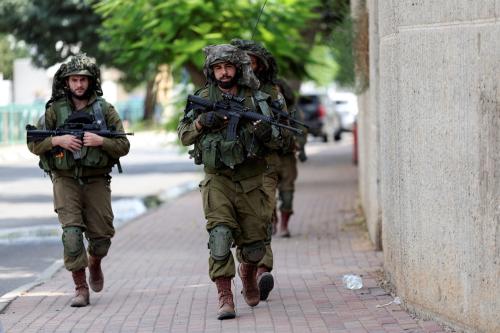The flow of foreign fighters to Syria to join the war against Bashar Assad’s dictatorship is becoming the largest in the history of the global jihad, and the Syrian battleground is on the way to outstripping the 1980s Afghan war against the Soviets as a training ground for Islamic militants. Security services around the world are becoming increasingly alarmed at the implications for the safety of their citizens.
American intelligence officials now put the number of foreign fighters who have gone to Syria since the war began in 2011 at between 8,000 and 10,000. Other sources put the total even higher, up to 12,000. The largest contingent is probably Saudis. Saudi sources put the number of their citizens who have gone to wage jihad in Syria at 1,200, of whom 300 are reported to have died on the battlefield. Jordanian sources report about a thousand Jordanians have gone to fight in their northern neighbor. Figures for other Arab countries are largely unavailable. There are no coherent governments counting the flow of fighters from broken states like Yemen, Libya or Iraq, but we know from previous experience they are likely sources of jihadists.
Virtually every country in Western Europe has reported that some of its Muslim citizens have gone to Syria. A small but significant number have died in the war and become martyrs back in the United Kingdom, France, Belgium, and other states with sizable Muslim minorities. Even tiny Luxembourg has had one jihadi martyr already. Americans are now fighting in Syria as well.
In comparison, the war against the Soviet 40th Red Army in Afghanistan in the 1980s attracted an estimated 20,000 foreign volunteers over a decade, according to the estimate of the American intelligence community when the Russians retreated from Afghanistan in 1989. So Afghanistan attracted more volunteers, but over a longer time period. If Syria continues to attract foreign fighters at the rate we have seen so far and the civil war goes on for a decade, the Syrian war is all but certain to be an even larger factory for extremism than Afghanistan.
Syria is worrisome in other ways as well. Many of the so-called Arab Afghans who came to Pakistan and Afghanistan in the 1980s were labeled “tourist jihadis” at the time. Considerable numbers of the Arab and other Muslim volunteers in the ‘80s never actually crossed the border from Pakistan into Afghanistan to fight the Russians. They got their pictures taken with an AK47 assault rifle in the Afghan refugee camps and the training bases of the mujahedin in Pakistan, endured a few months hardship and then they went home to boast of their “experience” in jihad.
Even those who did fight against the Russians played only a marginal role in determining the outcome of the war. The best estimate available of the total number of Arab Afghans who died on the battlefield in the 1980s is no more than 500. Over a million Afghans died in the war. The vast bulk of the fighting was done by thousands of Afghan mujahedin backed by several hundred Pakistani intelligence officers from the ISI and Pakistan special forces commandoes. With a few notable exceptions (Osama bin Laden being the most important) the Arab Afghans were not regarded by either the mujahedin or the ISI as serious contributors to the war effort. They were good for fundraising, medical services and public relations purposes, not combat.
That is not the case in Syria today. Foreign fighters are a mainstay of the rebellion against Assad. Especially in the extremist factions like al Qaeda’s Al Nusra Front or the even more radical Islamic State of Iraq and al Shams group (expelled from al Qaeda this winter for its extremism), the foreign volunteers are a major source of manpower for the war. The foreign fighters are often the most fanatical on the battlefield. They probably make up the majority of suicide bombers. In Afghanistan in the 1980s there were no suicide bombers—the mujahedin then did not feel that was a heroic way to fight or die.
The blowback from the Afghan war was massive and enduring. As early as 1991 Algerian veterans of the Afghan war were a critical ingredient in starting the Algerian civil war that ultimately claimed an estimated 150,000 lives. Afghan veterans in Egypt played a role in the wave of terror that swept Cairo and other Egyptian cities in the 1990s. The Who’s Who of the Global Jihad is full of Afghan war veterans from bin Laden to his successor, the Egyptian Ayman Zawahiri, who was a doctor in the refugee camps during the war. Of course the most dangerous blowback of the war was the role it played in creating the ideology of global jihad. The father of that ideology was an Afghan war veteran, Abdallah Azzam, a Palestinian who was bin Laden’s first partner in attracting foreign fighters to come to Afghanistan.
Few volunteers in the 1980s came from the Muslim Diaspora in Europe and North America. Now there are dozens of fighters in Syria who have American and European passports and will come home if they survive the war. For the intelligence and security services of the Western allies the specter of dozens of battle-hardened, experienced fanatics returning to their homes full of anger and resentment is a very deeply troubling one.
This article was originally published by The Daily Beast.



Commentary
Op-edSyria’s Terror Blowback Threatens Europe and the United States
May 5, 2014